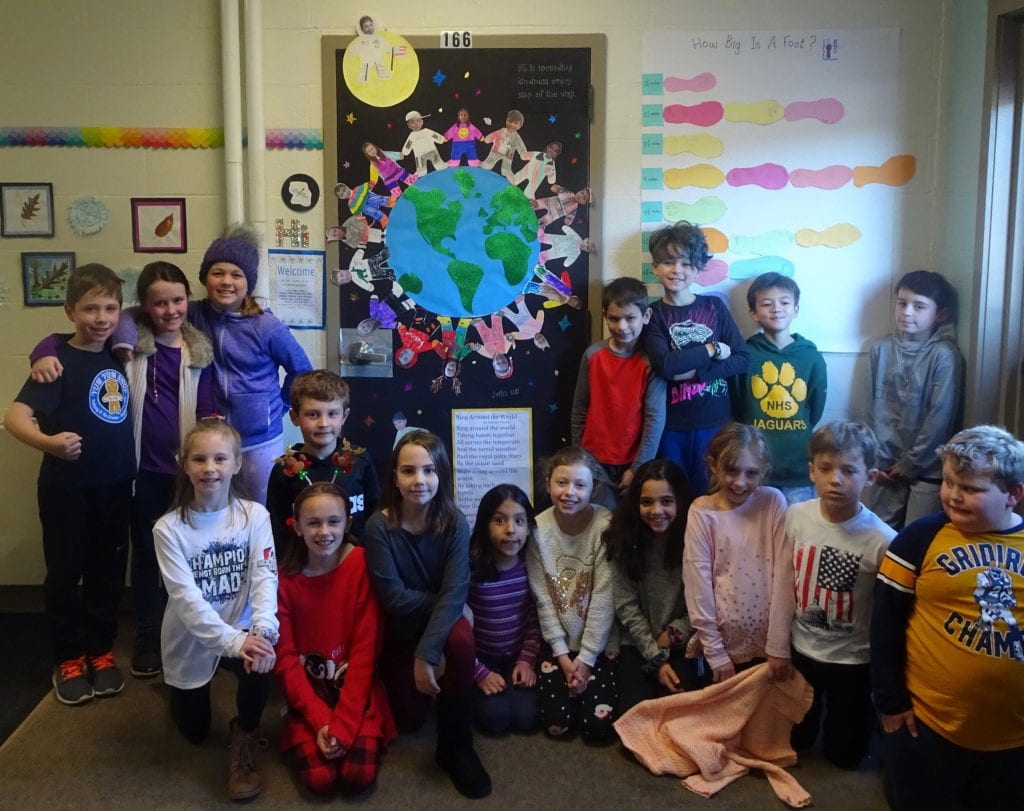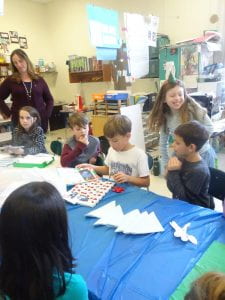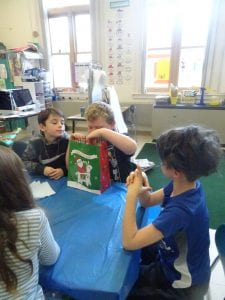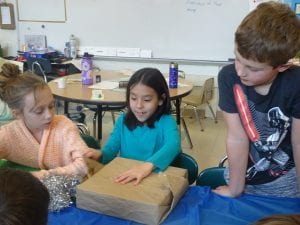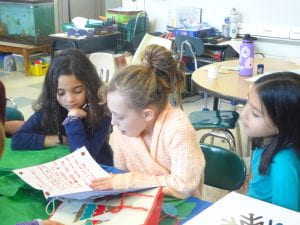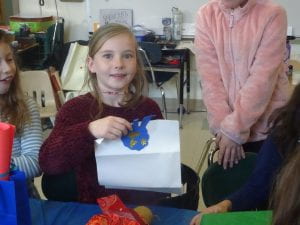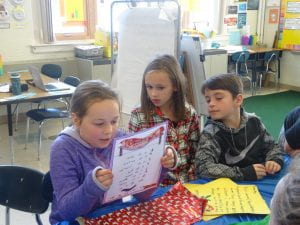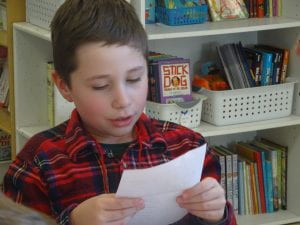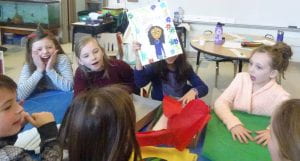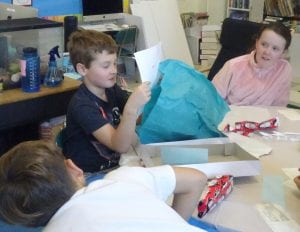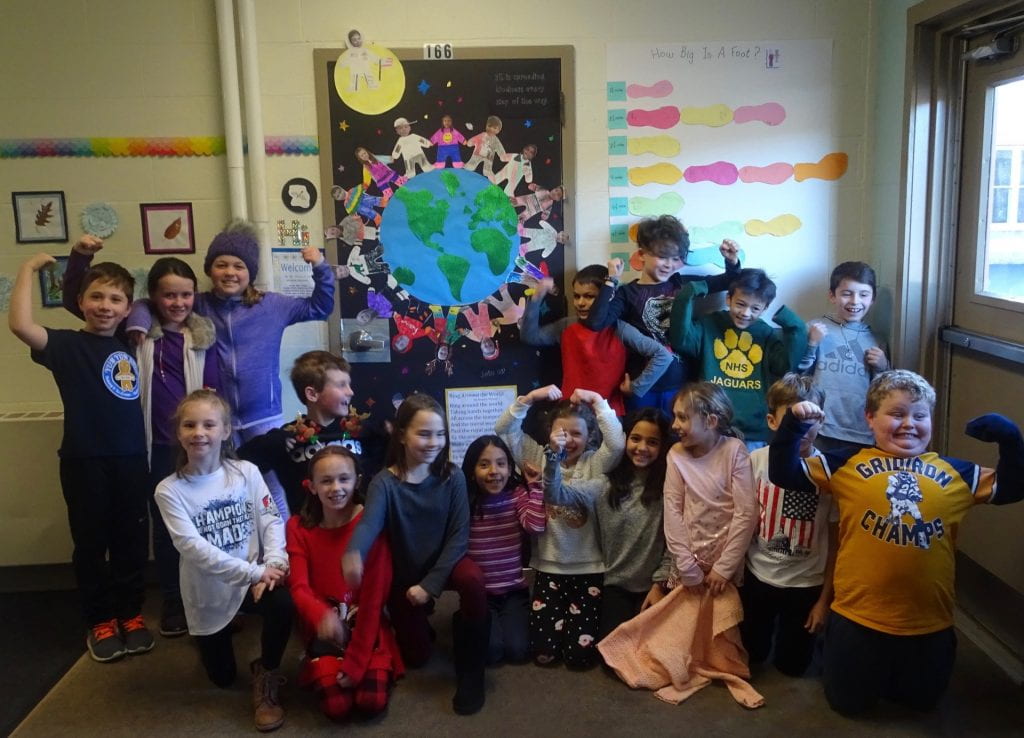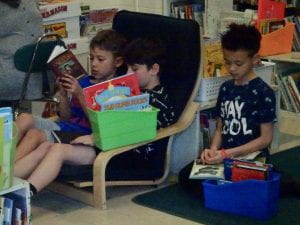 Our weeks continue to fly by. That’s a good thing; it means we are busy learning new things. We’re further examining how multiplication and division are related. We’ve learned how to write all of the upper – and lower-case cursive letters. We’re exploring weather and learning to read clouds. We have been trying to use all that we know to create interesting and effective pieces of writing. We’re putting our travel journals together and getting ready to create our souvenir collections so each student can share the Wonders of their country.
Our weeks continue to fly by. That’s a good thing; it means we are busy learning new things. We’re further examining how multiplication and division are related. We’ve learned how to write all of the upper – and lower-case cursive letters. We’re exploring weather and learning to read clouds. We have been trying to use all that we know to create interesting and effective pieces of writing. We’re putting our travel journals together and getting ready to create our souvenir collections so each student can share the Wonders of their country.
Studying Weather
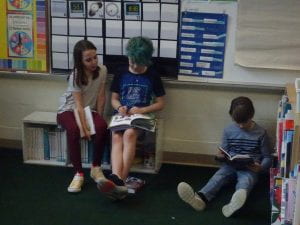 This week in science we explored the mystery, “How can you predict when it’s going to storm?” We learned about differences between fair weather clouds and storm clouds, and the role of wind direction in determining whether a rain cloud will pass overhead. You can continue to support your child’s curiosity by looking at clouds together and asking, “What kind of clouds do you think those are? I wonder if it will rain.” Ask your child to tell you about their Storm Spotter’s Guide, a small book they made to help them remember how to use the clouds to predict the weather.
This week in science we explored the mystery, “How can you predict when it’s going to storm?” We learned about differences between fair weather clouds and storm clouds, and the role of wind direction in determining whether a rain cloud will pass overhead. You can continue to support your child’s curiosity by looking at clouds together and asking, “What kind of clouds do you think those are? I wonder if it will rain.” Ask your child to tell you about their Storm Spotter’s Guide, a small book they made to help them remember how to use the clouds to predict the weather.
SEL – Sorting and Solving Problems in Positive Ways
In Open Circle this week, we began a multi-lesson unit on problem solving. In the coming weeks, we will be learning to use a six-step process for solving people problems. We began by talking about what a problem is. A problem is any situation that causes someone to be upset or confused. We made a list of problems that students in 3rdgrade might have, in the cafeteria, at recess or with friends. We tried to focus on school-based problems so we can deal with them more productively.
To help us learn and remember the problem-solving steps, we use the colors of a traffic signal: Red = Stop. Yellow = Think. Green = Go.
RED reminds us to STOP.
- Calm down.
- Identify the problem.
YELLOW reminds us to THINK:
- Decide on a positive goal.
- Think of several solutions.
- Evaluate solutions.
GREEN tells us to GO:
- Make a plan and try it.
 Once we’ve practiced using these problem solving steps the children will bring home a sign to post in your home as a reminder that they have an effective strategy for dealing with problems as they arise.
Once we’ve practiced using these problem solving steps the children will bring home a sign to post in your home as a reminder that they have an effective strategy for dealing with problems as they arise.
Bits and Pieces –
- We’ve just begun the 4thpart of Winterhouse. Will Gracella come? How are the Heimses involved in the issue? Why did Elizabeth find “the book?” What is “the feeling” that Elizabeth gets? Why does she do thing so impulsively? Talk to your child to see what he or she thinks about the mystery.
- Families that had to reschedule conference due to my father’s illness, please look for a conference sign-up in the front of your child’s folder this week. I hope we will be able to fit them all in next week before repots cards go home on March 20.
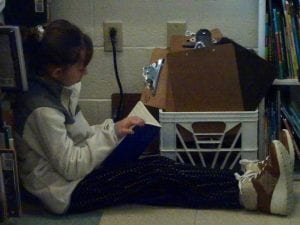 A note about report cards: They will be sent to you on March 20. Please be expecting that your child will have earned a combination of 2’s and 3’s in the second term. The children are learning and need support and guidance at this time. Also, Ms. Coronato and I decided that we would not be assessing student’s knowledge and understanding of the science standards involved in the Weather Unit we have just begun. It did not seem wise to assess their mastery based on a few activities. You will see NA in science this term.
A note about report cards: They will be sent to you on March 20. Please be expecting that your child will have earned a combination of 2’s and 3’s in the second term. The children are learning and need support and guidance at this time. Also, Ms. Coronato and I decided that we would not be assessing student’s knowledge and understanding of the science standards involved in the Weather Unit we have just begun. It did not seem wise to assess their mastery based on a few activities. You will see NA in science this term.
 This week has been about enjoying books, reading together, exploring weather and learning more about fractions and the connection between multiplication and division.
This week has been about enjoying books, reading together, exploring weather and learning more about fractions and the connection between multiplication and division. It was wonderful to see so many you at the Jaggies today. The awards ceremony was a wonderful way to celebrate how reading can bring us together as a school. What fun!
It was wonderful to see so many you at the Jaggies today. The awards ceremony was a wonderful way to celebrate how reading can bring us together as a school. What fun!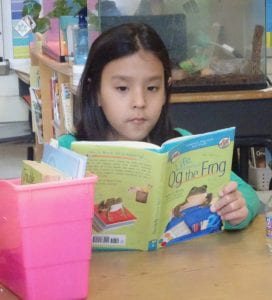 We’ve continued to sort problems and talk about how we could or should deal with situations that feel annoying. What should we do when people talk over each other? What should we do when people call others names (we agreed this happens more often at home with siblings)? What should we do when people fall on us in basketball?
We’ve continued to sort problems and talk about how we could or should deal with situations that feel annoying. What should we do when people talk over each other? What should we do when people call others names (we agreed this happens more often at home with siblings)? What should we do when people fall on us in basketball?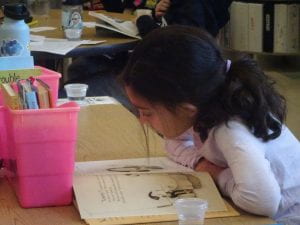 This week we learned more about the water cycle and different cloud types. We watched a Mystery Science video about how clouds are formed and then conducted an experiment where we captured water vapor so we could understand what a cloud feels like. It is cool and wet.
This week we learned more about the water cycle and different cloud types. We watched a Mystery Science video about how clouds are formed and then conducted an experiment where we captured water vapor so we could understand what a cloud feels like. It is cool and wet.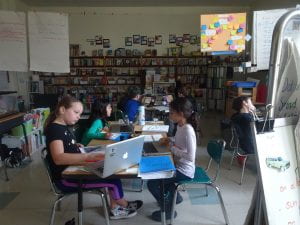 Most of the children have completed the research portion of this project are now on to the writing portion. They are creating a travel journal sharing the sites in their country that they think are interesting. The children are getting better at note-taking, though some of them are still tempted to copy what they read and call it their own. You’ll know if that is what your child is doing when you read their pages.
Most of the children have completed the research portion of this project are now on to the writing portion. They are creating a travel journal sharing the sites in their country that they think are interesting. The children are getting better at note-taking, though some of them are still tempted to copy what they read and call it their own. You’ll know if that is what your child is doing when you read their pages.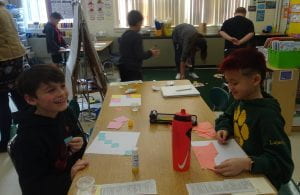 We’ve continued to learn more of the
We’ve continued to learn more of the
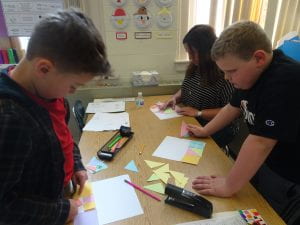 Thank you, again, for you kind words and your patience. I was hopeful that on Monday we’d be making a plan for my dad’s transition from the hospital. I thought I would know dates and could plan conference time with you. I’m sorry to say that did not happen, and I did not follow up on that to reschedule conferences. The second term ends on March 13 and report cards will be sent home on March 20.
Thank you, again, for you kind words and your patience. I was hopeful that on Monday we’d be making a plan for my dad’s transition from the hospital. I thought I would know dates and could plan conference time with you. I’m sorry to say that did not happen, and I did not follow up on that to reschedule conferences. The second term ends on March 13 and report cards will be sent home on March 20. We’ve had a full week. Thanks for your support of Spirit Week. That’s been a fun way to lead into vacation. We’ve continued to learn about fractions. We’ve compared them and looked for equivalent fractions as well. We’ve begun to learn upper case cursive letters. The children are excited to write their names. It is fun to see cursive appearing here and there as they write.
We’ve had a full week. Thanks for your support of Spirit Week. That’s been a fun way to lead into vacation. We’ve continued to learn about fractions. We’ve compared them and looked for equivalent fractions as well. We’ve begun to learn upper case cursive letters. The children are excited to write their names. It is fun to see cursive appearing here and there as they write.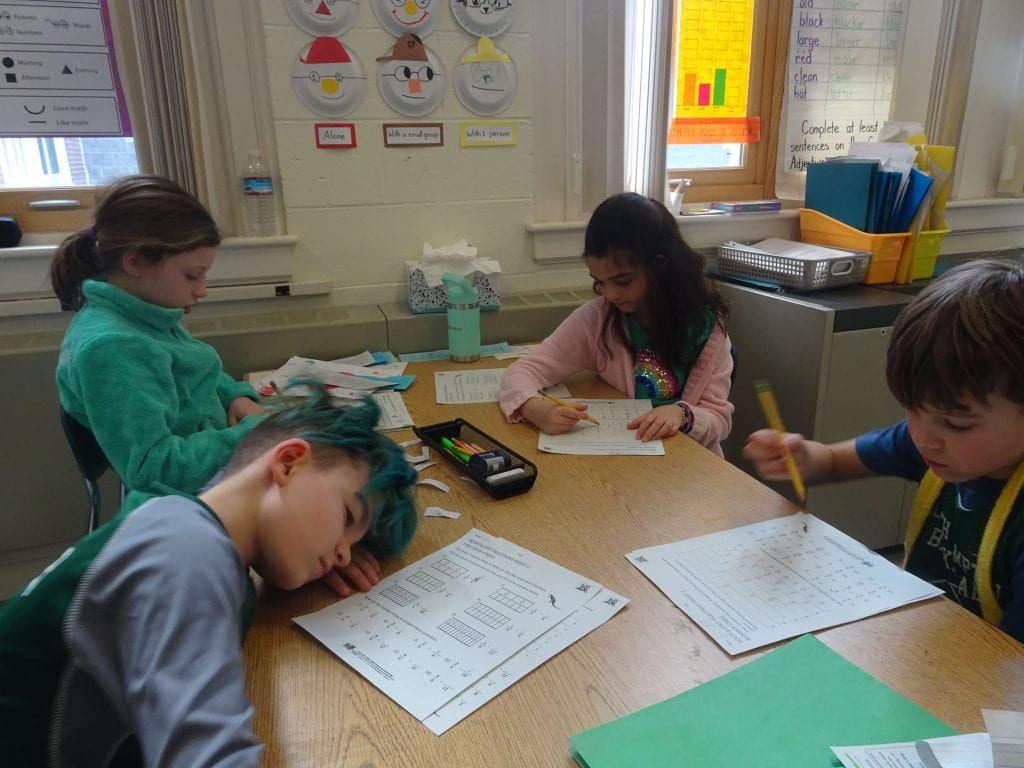 We’ve learned about the three main cloud types and are beginning to notice and name them as part of our morning routine. We hope to become more aware of the changing weather around us.
We’ve learned about the three main cloud types and are beginning to notice and name them as part of our morning routine. We hope to become more aware of the changing weather around us.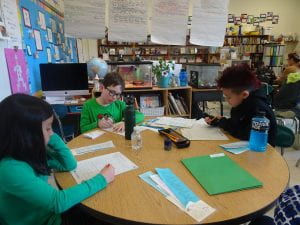 Elena – In Mexico cacti can reach 6 feet tall.
Elena – In Mexico cacti can reach 6 feet tall.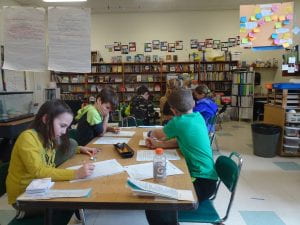 Brady – The make rain sticks in Chile.
Brady – The make rain sticks in Chile.
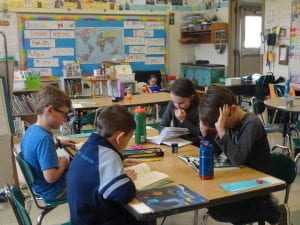 Happy Valentines’ Day!
Happy Valentines’ Day! Our Open Circle discussions have been focused on discussing how to positively deal with “annoying” behavior. We’ve been learning how to respond in ways that can be both firm, and kind. We are trying not to just say, “Stop it.” We are trying to say, “I am _______ when you _____. Could you please ____” It is challenging to remember all of this steps when annoyed. It can also be challenging to accept the statement with grace.
Our Open Circle discussions have been focused on discussing how to positively deal with “annoying” behavior. We’ve been learning how to respond in ways that can be both firm, and kind. We are trying not to just say, “Stop it.” We are trying to say, “I am _______ when you _____. Could you please ____” It is challenging to remember all of this steps when annoyed. It can also be challenging to accept the statement with grace.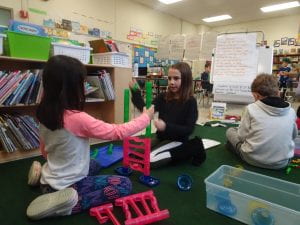 We’ve continued our study of comparative and superlative spelling rules. This has been a great review of long and short vowel sounds and syllabification rules. We need to know vowel sounds so we know when to double the final consonant before adding the suffix. And we need to be able to count syllables so we know when to use more and less and most and least. We’ve had fun collecting adjectives as we read and changing them when adding –er and –est.
We’ve continued our study of comparative and superlative spelling rules. This has been a great review of long and short vowel sounds and syllabification rules. We need to know vowel sounds so we know when to double the final consonant before adding the suffix. And we need to be able to count syllables so we know when to use more and less and most and least. We’ve had fun collecting adjectives as we read and changing them when adding –er and –est.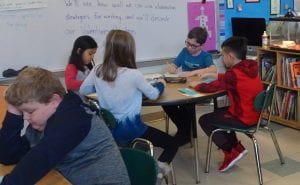 Adjectives are an important part of using elaboration strategies. We’ve begun to notice them more in the books we’ve been reading and we’ve come to realize how important they are. Adjectives really help paint pictures in our readers’ minds. They are the words that help our readers understand our meaning and intention. During our comparative/superlative work, we’ve been collecting them from books we’ve been reading. There are a lot of adjectives there – some on each page. We have realized we don’t use many adjectives in our own writing and we’re trying to be more mindful of that.
Adjectives are an important part of using elaboration strategies. We’ve begun to notice them more in the books we’ve been reading and we’ve come to realize how important they are. Adjectives really help paint pictures in our readers’ minds. They are the words that help our readers understand our meaning and intention. During our comparative/superlative work, we’ve been collecting them from books we’ve been reading. There are a lot of adjectives there – some on each page. We have realized we don’t use many adjectives in our own writing and we’re trying to be more mindful of that.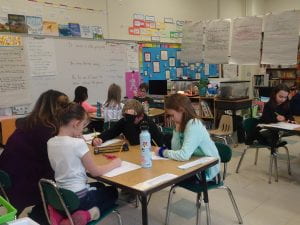 We hope that the children will have completed the research portion of the global geography project by the time we leave for February vacation. Many of the children are in a great place for that. A few of the children, though, have used their time scanning images and listening to short videos rather than actually choosing places to learn more about in detail. If you have a chance, talk to your child about the landmarks they have discovered. If they don’t know any, or can only tell you the name of the historic event or national holiday, it would be greatly appreciated if you would encourage your child to spend more time focused on discovering the facts and details. Digging deep and trying to understand is challenging. There are so many new words and difficult ideas to understand it can be a struggle to read for understanding. Please encourage your child to use books, if they have them. These are much more focused than the Internet resources. While less glamorous, they can be easier to understand.
We hope that the children will have completed the research portion of the global geography project by the time we leave for February vacation. Many of the children are in a great place for that. A few of the children, though, have used their time scanning images and listening to short videos rather than actually choosing places to learn more about in detail. If you have a chance, talk to your child about the landmarks they have discovered. If they don’t know any, or can only tell you the name of the historic event or national holiday, it would be greatly appreciated if you would encourage your child to spend more time focused on discovering the facts and details. Digging deep and trying to understand is challenging. There are so many new words and difficult ideas to understand it can be a struggle to read for understanding. Please encourage your child to use books, if they have them. These are much more focused than the Internet resources. While less glamorous, they can be easier to understand. We’ve begun to learn about weather. We’ve been reading about how air, water and heat interact to create weather. This week we’ve begun learning about clouds. We’ve discovered the three main types: cirrus, cumulus and stratus. And we are learning how to identify them and the huge variety of combinations as they give us a hint about how to predict changes in the up-coming weather.
We’ve begun to learn about weather. We’ve been reading about how air, water and heat interact to create weather. This week we’ve begun learning about clouds. We’ve discovered the three main types: cirrus, cumulus and stratus. And we are learning how to identify them and the huge variety of combinations as they give us a hint about how to predict changes in the up-coming weather.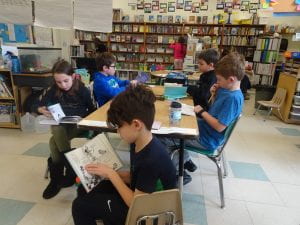 Talk to your child about Winterhouse. We think we have gotten to the problem part of the story, but even this is building. It is exciting!
Talk to your child about Winterhouse. We think we have gotten to the problem part of the story, but even this is building. It is exciting!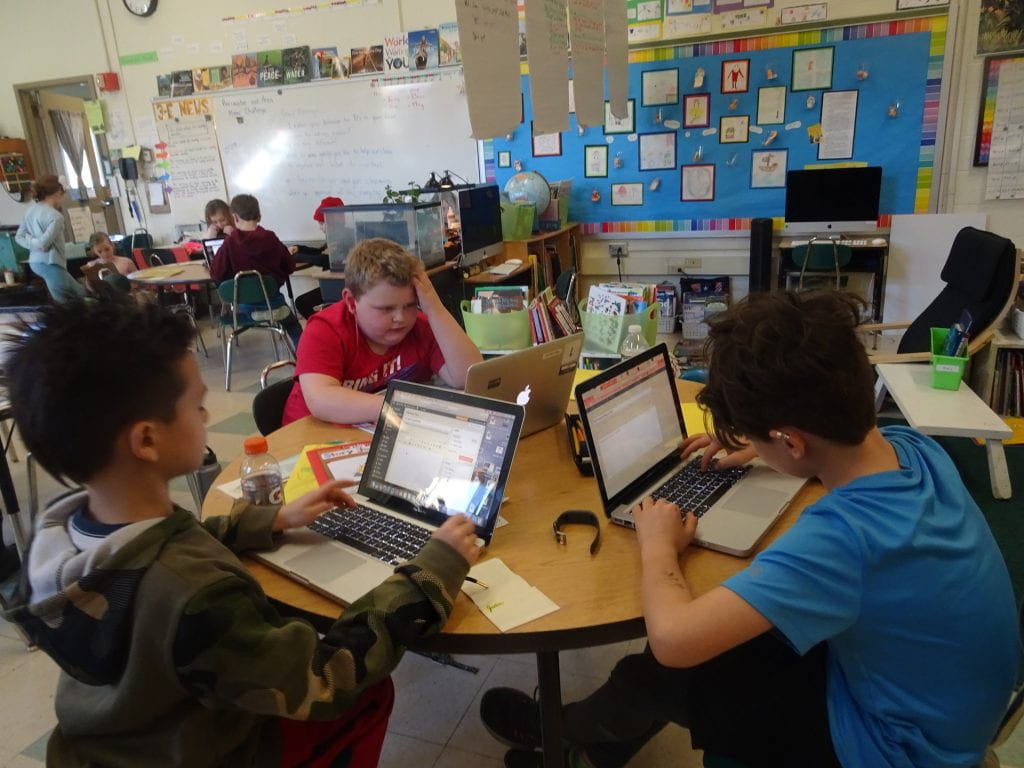 As I am preparing for conferences next week, I have again been stuck by what a huge growth year 3rdgrade is. Our curriculum is divided into grade spans. Third grade is the first year in the 3 to 5 span and what they are expected to accomplish is a lot. They are working hard to do that. I appreciate their attention and efforts.
As I am preparing for conferences next week, I have again been stuck by what a huge growth year 3rdgrade is. Our curriculum is divided into grade spans. Third grade is the first year in the 3 to 5 span and what they are expected to accomplish is a lot. They are working hard to do that. I appreciate their attention and efforts.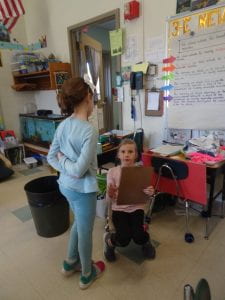 This week we’ve begun a new set of discussions about problems and behaviors. We’ve learned that dangerous and destructive problems are ones where you really need to get help. When you’re afraid you or someone else will get hurt you need to get help from an adult. When you see that things are being ripped and ruined you need to get help. We’ve also talked about “annoying” behavior as different from dangerous and destructive behavior. Our class definition of annoying behavior is that it is something that distracts attention from the appropriate task, is repetitive (not just once), and might be intentionally teasing.
This week we’ve begun a new set of discussions about problems and behaviors. We’ve learned that dangerous and destructive problems are ones where you really need to get help. When you’re afraid you or someone else will get hurt you need to get help from an adult. When you see that things are being ripped and ruined you need to get help. We’ve also talked about “annoying” behavior as different from dangerous and destructive behavior. Our class definition of annoying behavior is that it is something that distracts attention from the appropriate task, is repetitive (not just once), and might be intentionally teasing. We’ve been exploring plot and the plot line of narratives. We’ve been climbing story mountains together and individually. We’ve been noticing how stories begin with a lead that establishes who the main characters are and initiates the main action. This is followed by a series of small events and descriptive details that build to the main problem. This problem is something that the characters have to deal with and find a way to get through it. The main character learns something or is changed when the problem is resolved. And finally, the story ends in a way that connects back to the beginning. The story has come full circle.
We’ve been exploring plot and the plot line of narratives. We’ve been climbing story mountains together and individually. We’ve been noticing how stories begin with a lead that establishes who the main characters are and initiates the main action. This is followed by a series of small events and descriptive details that build to the main problem. This problem is something that the characters have to deal with and find a way to get through it. The main character learns something or is changed when the problem is resolved. And finally, the story ends in a way that connects back to the beginning. The story has come full circle.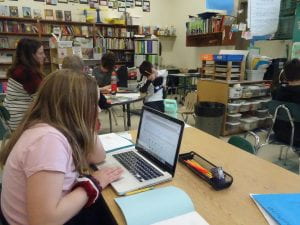 You’ll see a couple examples this work in your child’s folder this week. Some of the children easily follow the characters through the story. They connect with them and recognize how they are interacting with the action of the story. Others find it more challenging to follow the character’s growth throughout the story. When you are reading together, talk to you child about the story mountain found in the books you are sharing. It will strengthen his/her understanding of the story and build inferential comprehension skills too.
You’ll see a couple examples this work in your child’s folder this week. Some of the children easily follow the characters through the story. They connect with them and recognize how they are interacting with the action of the story. Others find it more challenging to follow the character’s growth throughout the story. When you are reading together, talk to you child about the story mountain found in the books you are sharing. It will strengthen his/her understanding of the story and build inferential comprehension skills too.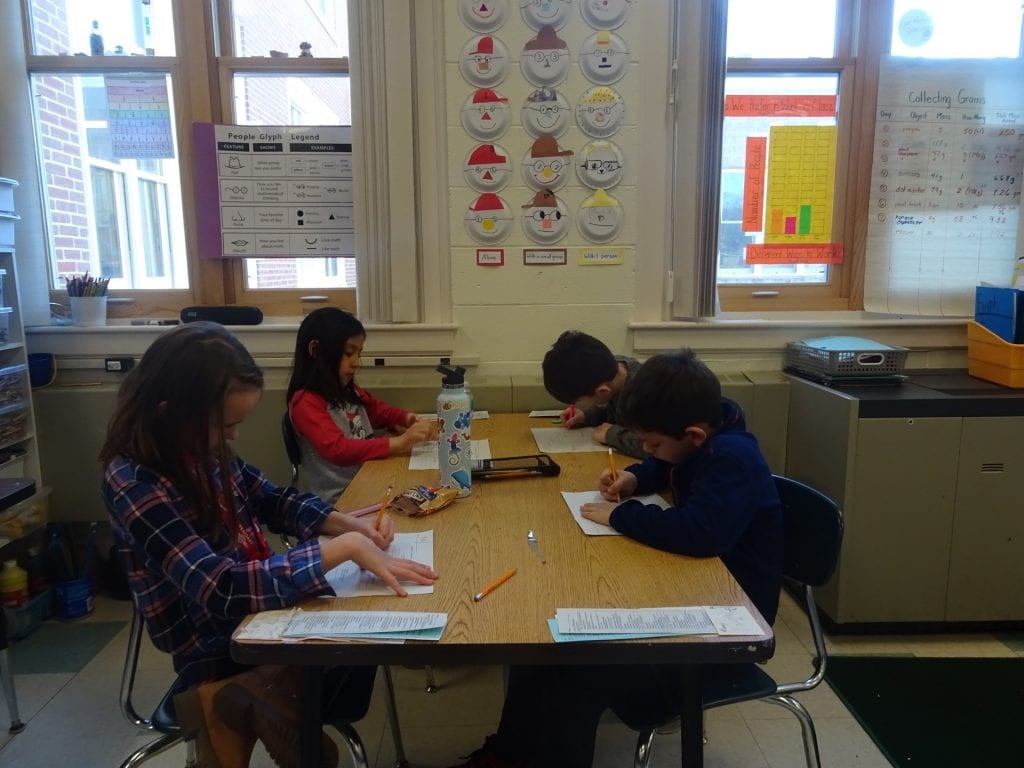 Earlier in the year we learned how to develop more descriptive sentences by adding adjectives, and details telling when, where, why and how. A simple sentence can become quite interesting. We also learned about the “power of 3” to help guide our choices because generally three is enough. Three adjectives, three actions, or three repetitions are enough to make the idea stick without becoming monotonous.
Earlier in the year we learned how to develop more descriptive sentences by adding adjectives, and details telling when, where, why and how. A simple sentence can become quite interesting. We also learned about the “power of 3” to help guide our choices because generally three is enough. Three adjectives, three actions, or three repetitions are enough to make the idea stick without becoming monotonous.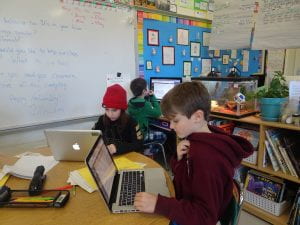 We are continuing to
We are continuing to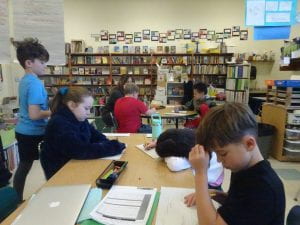 Our next science unit is
Our next science unit is  This week we began our global geography inquiry. In Open Circle we’ve been talking about speaking up and setting goals. We’ve been reading books around the theme of kindness while we learn about plot lines and we’ve been practicing our kite string letters in cursive.
This week we began our global geography inquiry. In Open Circle we’ve been talking about speaking up and setting goals. We’ve been reading books around the theme of kindness while we learn about plot lines and we’ve been practicing our kite string letters in cursive.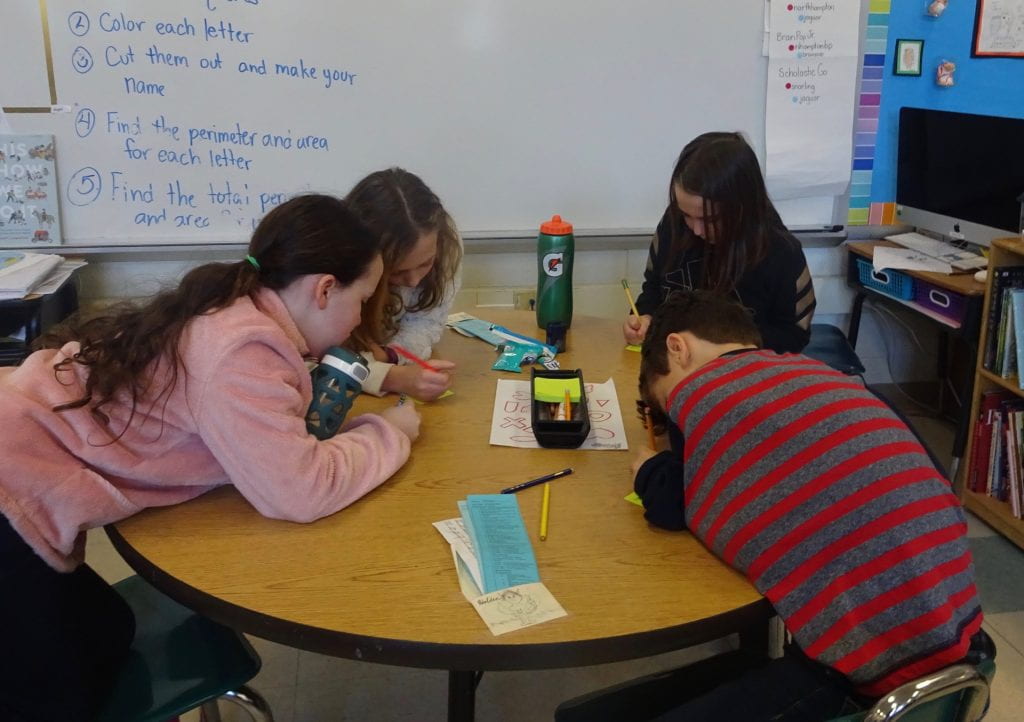 We’ve read several books this week that help us consider what it means to be kind. It seems that it is the little things that matter most. We’re trying to see how we can make choices throughout our day that show others we are choosing kindness by following the rules and meeting classroom and school expectations so everyone has the opportunity to learn.
We’ve read several books this week that help us consider what it means to be kind. It seems that it is the little things that matter most. We’re trying to see how we can make choices throughout our day that show others we are choosing kindness by following the rules and meeting classroom and school expectations so everyone has the opportunity to learn. The children started learning about the flag and are now exploring geography and landforms, unique plant and animals, historic sites, cities and the countryside, museums, parts and monuments and cultural festivals and celebrations. The final project will be to create a travel journal demonstrating what you know about nonfiction features in writing and creating several souvenirs collected along the way. The children will“pack” the journal and the souvenirs into a suitcase they will have created and present their journey.
The children started learning about the flag and are now exploring geography and landforms, unique plant and animals, historic sites, cities and the countryside, museums, parts and monuments and cultural festivals and celebrations. The final project will be to create a travel journal demonstrating what you know about nonfiction features in writing and creating several souvenirs collected along the way. The children will“pack” the journal and the souvenirs into a suitcase they will have created and present their journey. Throughout January we’ve been learning about fractions and how they compare. Fractions are featured on our calendar this month. We’ve played fraction bingo and are creating our own fraction bar sets so we can learn more about equivalent fractions.
Throughout January we’ve been learning about fractions and how they compare. Fractions are featured on our calendar this month. We’ve played fraction bingo and are creating our own fraction bar sets so we can learn more about equivalent fractions.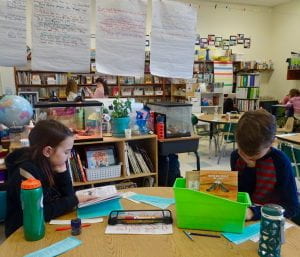 We’ve completed our second set of
We’ve completed our second set of 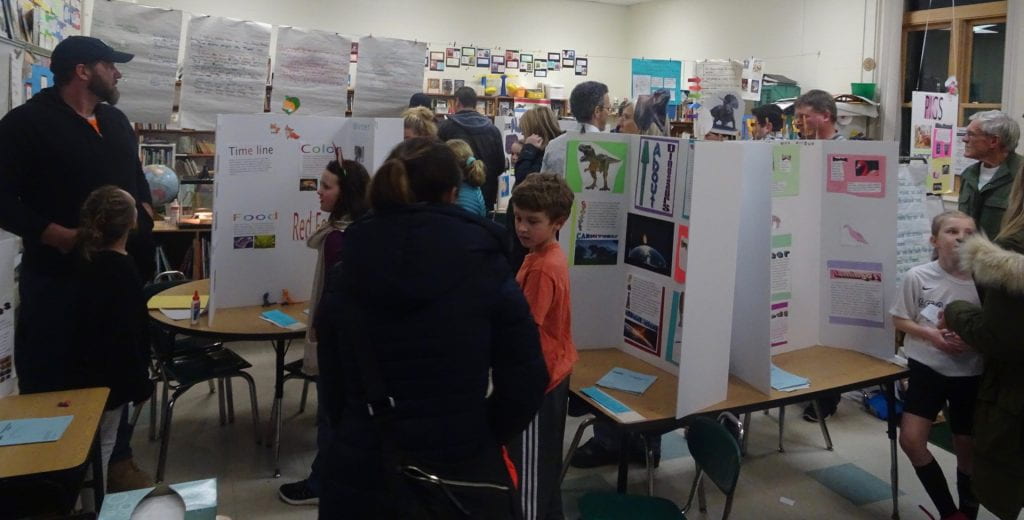 Thank you for supporting the children at 3E’s Inquiry Wonderland. They had a “wonder-full” time sharing their work with you. After the excitement of the museum, we’ve had an ordinary week of reading, writing and math.
Thank you for supporting the children at 3E’s Inquiry Wonderland. They had a “wonder-full” time sharing their work with you. After the excitement of the museum, we’ve had an ordinary week of reading, writing and math.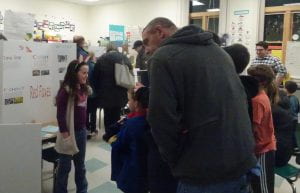 This week I asked the children to think closely about what they are reading. I’ve asked them to think about how their book choices are helping them grow as readers and thinkers. Many of the children are reading series together so they can talk about them – the Dogman and Amulet series are being read in this way. Some of the children prefer nonfiction and are reading the Magic Tree House fact guides.
This week I asked the children to think closely about what they are reading. I’ve asked them to think about how their book choices are helping them grow as readers and thinkers. Many of the children are reading series together so they can talk about them – the Dogman and Amulet series are being read in this way. Some of the children prefer nonfiction and are reading the Magic Tree House fact guides.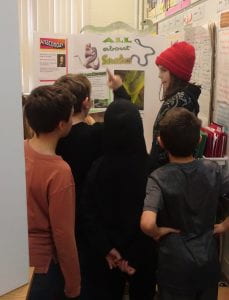 I’ve been conferencing and reading with the children to see if they are using any of the strategies we use during class read-alouds and in book clubs on their own to boost their understanding. Some of the children are, but most are not. Some of the children can talk about what they are thinking about as they read – how they are connecting with the characters or what they are learning, but most are not yet making those deep connections. This is something we’ll work to develop in the weeks to come.
I’ve been conferencing and reading with the children to see if they are using any of the strategies we use during class read-alouds and in book clubs on their own to boost their understanding. Some of the children are, but most are not. Some of the children can talk about what they are thinking about as they read – how they are connecting with the characters or what they are learning, but most are not yet making those deep connections. This is something we’ll work to develop in the weeks to come.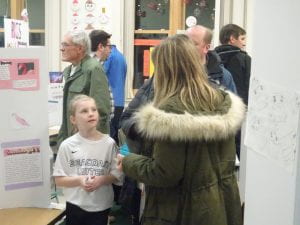 Writing dialogue is one technique that authors use to give their characters personality and to move a story along in time without explaining every moment. Writing dialogue also follows some specific rules: a new line for each speaker, the first line indented, quotation marks around the talking, including frequent dialogue tags and careful use of commas and end-mark punctuation.
Writing dialogue is one technique that authors use to give their characters personality and to move a story along in time without explaining every moment. Writing dialogue also follows some specific rules: a new line for each speaker, the first line indented, quotation marks around the talking, including frequent dialogue tags and careful use of commas and end-mark punctuation. We’ve been practicing this with partners. We’ve written about weekends and about our inquiry projects. We’ve created puppets and created dialogues for them as well. With each practice the children are becoming more skilled. Several of the children have been able to include accurately written and punctuated dialogues in their independent writing. That’s a great thing to see.
We’ve been practicing this with partners. We’ve written about weekends and about our inquiry projects. We’ve created puppets and created dialogues for them as well. With each practice the children are becoming more skilled. Several of the children have been able to include accurately written and punctuated dialogues in their independent writing. That’s a great thing to see. For the past several weeks one of the stations during our math block has been focused on developing an understanding of perimeter. The students have created and measured polygons made from straws and pipe cleaners. They measured a variety of triangles, quadrilaterals and hexagons taped on the floor and added the sides to find each perimeter. They have also measured things in classroom – most of these items have been rectangles. Several of the children realized they only needed to measure two of the sides and double to find the actual perimeter.
For the past several weeks one of the stations during our math block has been focused on developing an understanding of perimeter. The students have created and measured polygons made from straws and pipe cleaners. They measured a variety of triangles, quadrilaterals and hexagons taped on the floor and added the sides to find each perimeter. They have also measured things in classroom – most of these items have been rectangles. Several of the children realized they only needed to measure two of the sides and double to find the actual perimeter.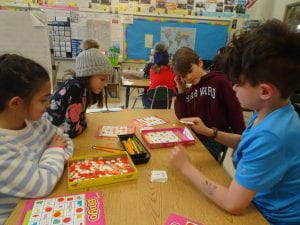
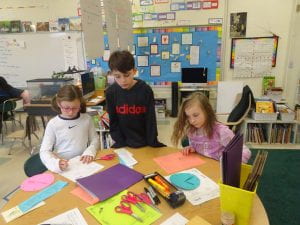 We finished The Mystery at Pine Lakeand discovered who had put the board in the dam that raised the water level and threatened the eggs in the loons’ nest. It was not who we thought it would be at all. That
We finished The Mystery at Pine Lakeand discovered who had put the board in the dam that raised the water level and threatened the eggs in the loons’ nest. It was not who we thought it would be at all. That 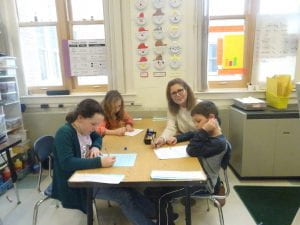 We are also continuing explore
We are also continuing explore 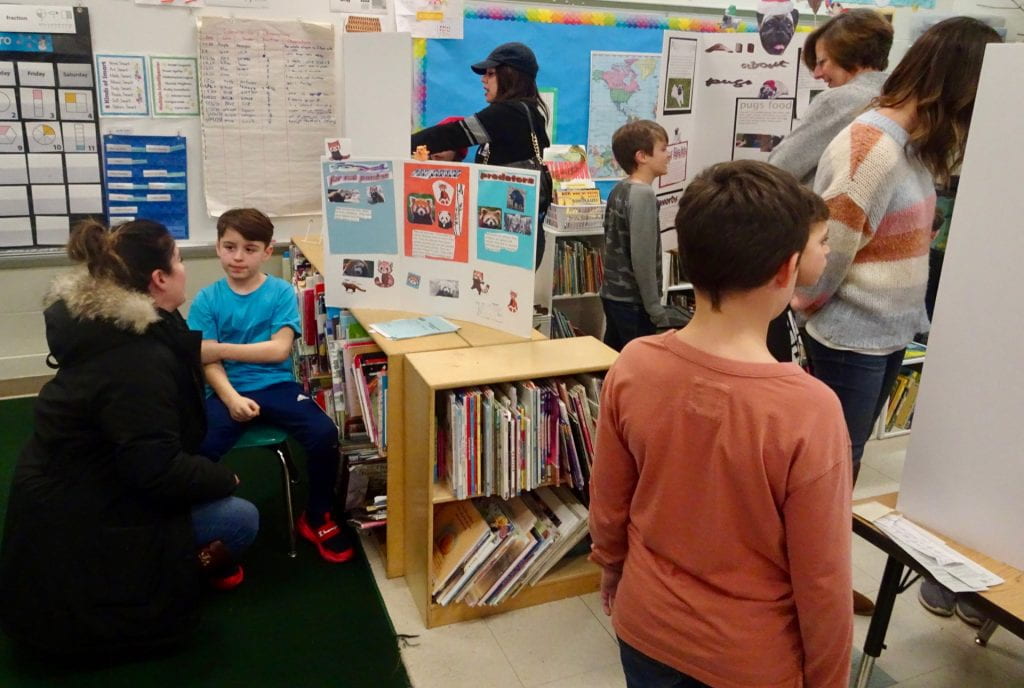
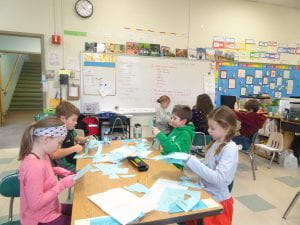 This week the children put the finishing touches on their inquiry research projects. They’ve done a lot and they are feeling proud of their accomplishments. We’ve been reading more about the world as we prepare for our next research project. We’re also learning about time and most exciting, has been learning cursive.
This week the children put the finishing touches on their inquiry research projects. They’ve done a lot and they are feeling proud of their accomplishments. We’ve been reading more about the world as we prepare for our next research project. We’re also learning about time and most exciting, has been learning cursive.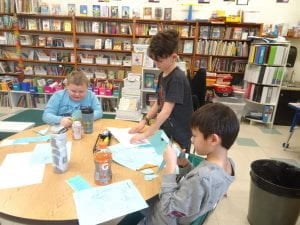 We are beginning to learn cursive letter formation. We are using a system called Loops and Groups. The letters are grouped according to how they are formed. Clock climbers start at the bottom, travel in an arch to 1 o’clock, retrace back down the line, curve up to complete the circle and then curve down to form the connector. We’ve learned a, d, g, q and c. It is challenging to keep the line going through all the letters and words. It is challenging to develop good letter formation habits – but mostly the class is having fun.
We are beginning to learn cursive letter formation. We are using a system called Loops and Groups. The letters are grouped according to how they are formed. Clock climbers start at the bottom, travel in an arch to 1 o’clock, retrace back down the line, curve up to complete the circle and then curve down to form the connector. We’ve learned a, d, g, q and c. It is challenging to keep the line going through all the letters and words. It is challenging to develop good letter formation habits – but mostly the class is having fun.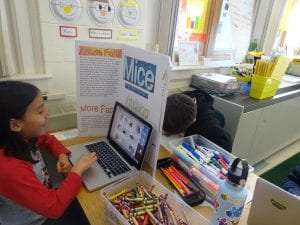 This week the children chose the name for their inquiry magazine. They decided to name it 1… 2… 3…Inquiry. They also designed the cover and created a picture representing their inquiry topic for it.
This week the children chose the name for their inquiry magazine. They decided to name it 1… 2… 3…Inquiry. They also designed the cover and created a picture representing their inquiry topic for it.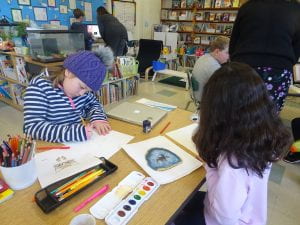 Everyone has completed all the parts of their project. Here are the steps behind what you will see. First they read, researched and took notes. Next they determined what was important and decided how to organize the information into categories and paragraphs. Then they designed and created their museum displays. Once the displays were done, they selected the information they wanted to share in a classroom magazine. They designed and created pages for that. (We hope this will be ready for the museum, though it may take a bit longer to be put together at the printer.) Next they create a picture to hang in the hallway outside the classroom. This is to give museumgoers a preview of what they will find inside. Each of these pictures is captioned with a sentence showing how we adjectives add detail to writing. And finally, the last piece of the project was to create a picture for the cover of the magazine. Yesterday was the deadline – and they are all ready. We can’t wait for you to come and see.
Everyone has completed all the parts of their project. Here are the steps behind what you will see. First they read, researched and took notes. Next they determined what was important and decided how to organize the information into categories and paragraphs. Then they designed and created their museum displays. Once the displays were done, they selected the information they wanted to share in a classroom magazine. They designed and created pages for that. (We hope this will be ready for the museum, though it may take a bit longer to be put together at the printer.) Next they create a picture to hang in the hallway outside the classroom. This is to give museumgoers a preview of what they will find inside. Each of these pictures is captioned with a sentence showing how we adjectives add detail to writing. And finally, the last piece of the project was to create a picture for the cover of the magazine. Yesterday was the deadline – and they are all ready. We can’t wait for you to come and see.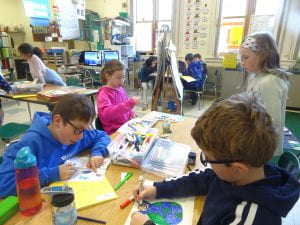 We hope when you come that you will tour each of the displays and talk to the researchers about their inquiry. They are ready to talk to you about why they chose their topic and the information they found most interesting as they researched and wrote. I know I have written this before, but please remember, we asked the children to get help with editing before printing. Some of them did, so their spelling and punctuation was corrected and some of them did not. We hope you can look beyond that, at this point. Learning that editing and revision is an important step in finishing is part of the process. Our next research project will begin next week. The children will have an opportunity to immediately apply what they learn from this project in that one.
We hope when you come that you will tour each of the displays and talk to the researchers about their inquiry. They are ready to talk to you about why they chose their topic and the information they found most interesting as they researched and wrote. I know I have written this before, but please remember, we asked the children to get help with editing before printing. Some of them did, so their spelling and punctuation was corrected and some of them did not. We hope you can look beyond that, at this point. Learning that editing and revision is an important step in finishing is part of the process. Our next research project will begin next week. The children will have an opportunity to immediately apply what they learn from this project in that one. We’ve created
We’ve created 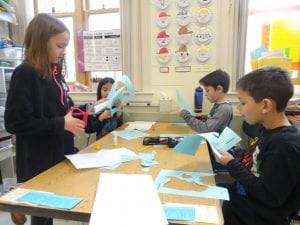
 Happy New Year! I hope you had a restful, healthy and wonderful vacation. It seems as though the children made wonderful memories – they were full of appreciation and had much to celebrate and share.
Happy New Year! I hope you had a restful, healthy and wonderful vacation. It seems as though the children made wonderful memories – they were full of appreciation and had much to celebrate and share.